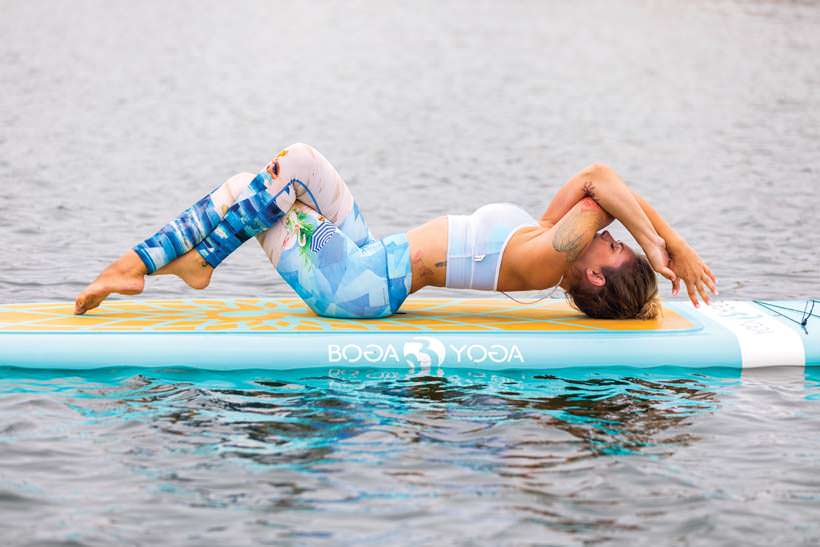
Photo of Sarah Tiefenthaler wearing Reebok on a Boga board by David Young-Wolff
If you haven’t tried it yet, it may be on your wish list: practicing yoga on a paddleboard floating in the water. Stand Up Paddleboard Yoga (commonly referred to as SUP Yoga) is a growing practice on bodies of water throughout the world. SUP Yoga is so much more than simply a platform for beautiful social media shots. This floating yoga mat in a floating yoga studio offers us the ability to cultivate an expansive relationship with our practice through the body, breath, board, water, and the environment. This is why I love SUP Yoga, there is nothing like the feeling of being on the board.
To understand my practice and why this is more than an ordinary yoga class, follow me on my journey…As I walk out into the ocean, gently sliding my board and paddle, I feel the water that rushes across my legs. I walk out just far enough so that my fin no longer grazes the sand beneath it. Then, I give the board a firm push forward and leap onto it in a kneeling position. I take a couple strong paddle strokes forward, plant my feet and stand.
In this moment, I take a deep breath of fresh ocean air. As I let the breath go, I feel a soft smile take shape. The sunlight hits my eyes and I feel its warmth on my skin. In a matter of minutes, I feel free. I continue to paddle, listening to the water with each stroke. I cross paths with familiar faces paddling or kayaking by with a chipper “good morning” and a friendly wave “hello.”
After about 20 minutes of paddling to wake up my body, I circle back to the calm water just off the sandy shoreline of the bay or cove. I toss down my anchor and feel my board slowly drift to a stop. I stow my paddle and splash a little salt water across the top of my board to clear away any sand. I take another full breath in, allow my eyes to close, and push back into a downward facing dog and let my breath go. While bending one leg and then the other, I softly open my eyes to see dancing sparkles on the surrounding water all around me. With every upward facing dog I gaze to the sky, while listening to seagulls chatter and children laughing on the playground nearby. When I settle into savasana (final relaxation) under the sun, under the sky, with the sound of the water gently lapping against my board and very softly rocking me side to side like a lullaby, I feel the magic of the present moment.
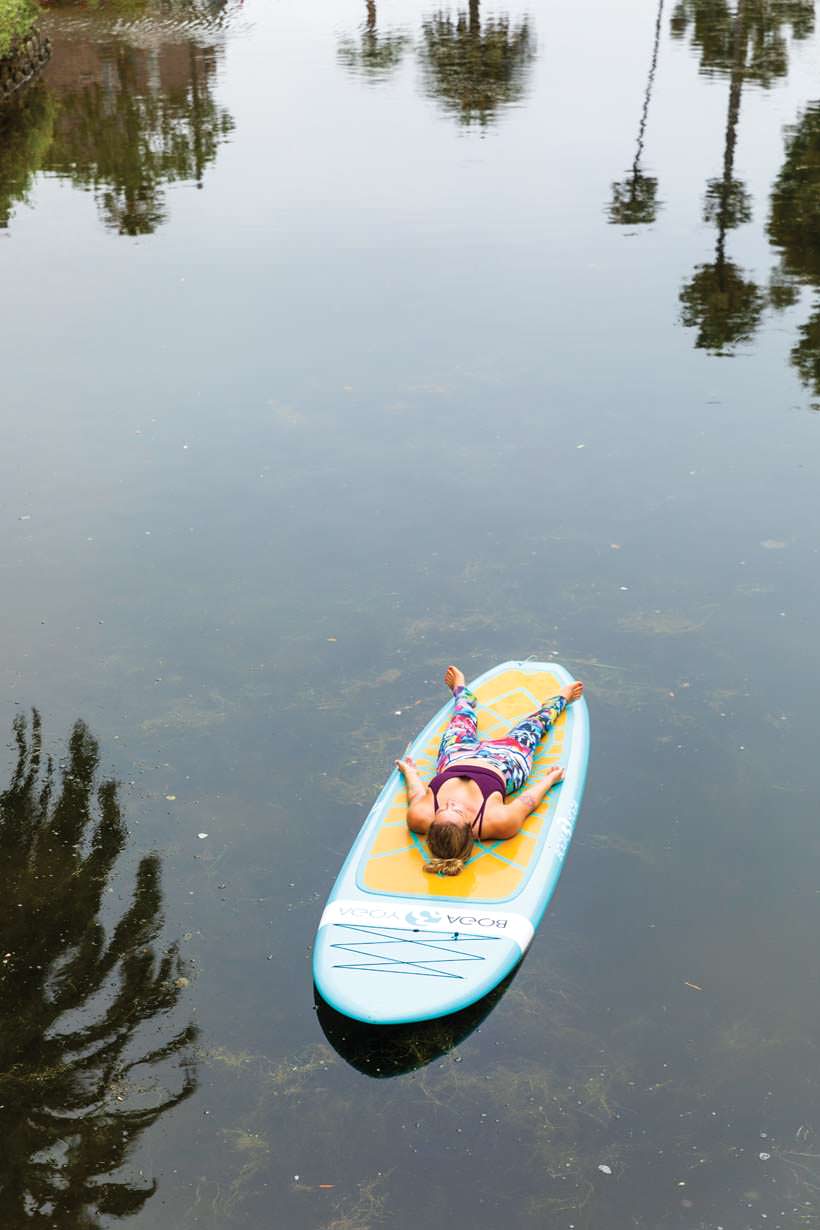
Sarah Tiefenthaler in Savasana during SUP Yoga. Clothing by Reebok. Board by BOGA. Photo by David Young-Wolff.
Every time I push a board out onto the water, I am reminded of my connection to the practice, to the natural world around, and to the breath and body; as soon as the ocean breeze hits my face, I’m home. I’m present. I am here now.
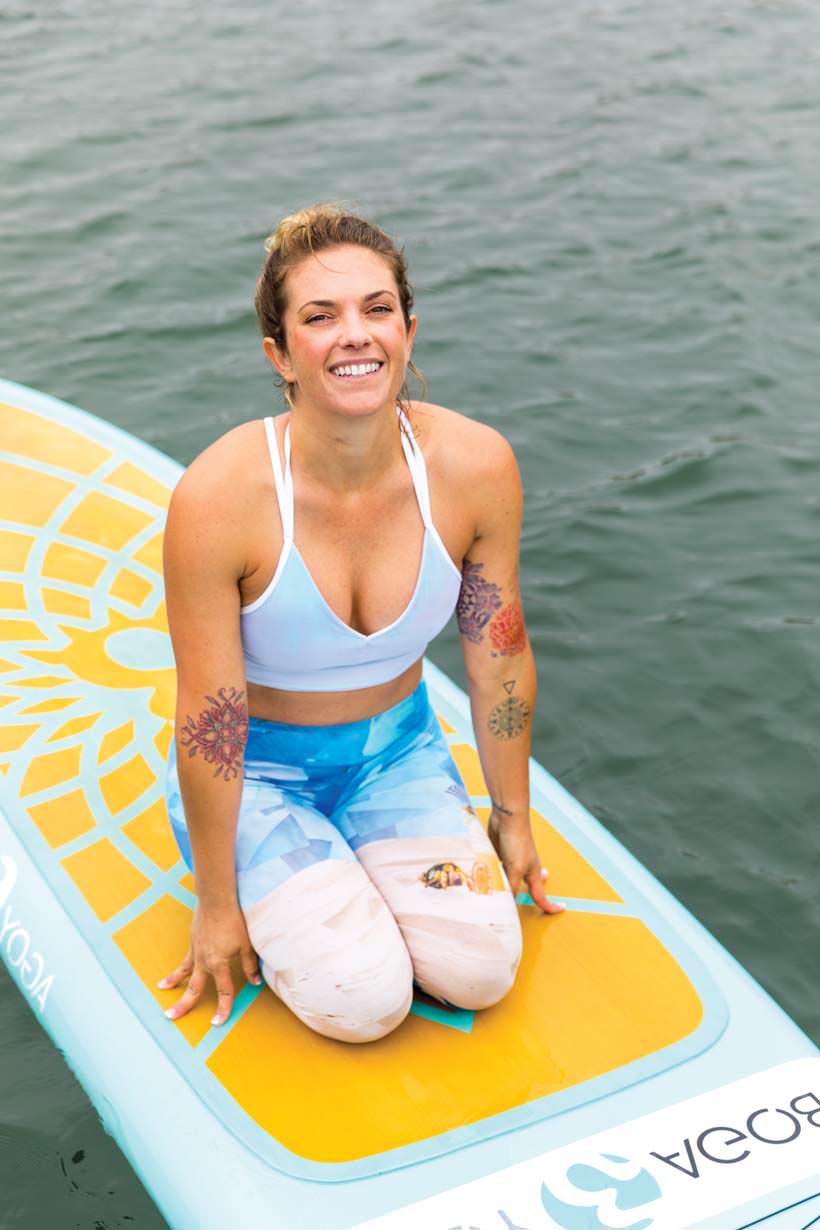
Sarah Tiefenthaler photographed by David Young-Wolff
I don’t feel like I found SUP Yoga, I feel like it found me. In October, 2010, I spent a month in Costa Rica earning my first (of three) yoga teaching certifications. After spending a month practicing yoga on a deck overlooking the tropical jungle, jumping off waterfalls, and daily swimming and hiking— my return to LA left me feeling a bit melancholy. I missed that daily presence in nature and I knew I had to find an activity that involved being outdoors.
As luck would have it, while I was away, a paddleboard shop opened in Venice Beach. I received an invitation to join a free paddle demo the very weekend I returned. Of course, I went! While receiving my first paddle instruction, I made a little joke about trying yoga on the board. The owners of the SUP shop challenged me to try, and better yet, to create a class. I accepted the challenge.
What to Know When You take a Class
Since the class is on the water, it is a good idea to already know how to swim. Every class begins with instruction on how to paddle and how to control your board. If you start out not knowing how to stand up and paddle, you will learn in class. If you start out your SUP Yoga adventure by taking a series of classes, you may hear these instructions multiple times, yet when it comes to maintaining a beginner’s mind, we all can use refreshers for the basics.
Generally, SUP Yoga classes are conducted on calm water. If you’re on the ocean, classes are scheduled in calm areas away from waves or boat traffic such as marinas, bays, coves, or quiet beaches. (You may encounter some marine life, but just to reassure you, I have never seen a great white shark in all of my years of SUP Yoga!) Classes may also be on lakes, ponds, or other bodies of water.
If you are looking for classes, you can ask people for suggestions or try checking out namastesup.com to find floating studios all over the world. You’ll be surprised how many there are. When you find one near you, call them and ask questions, ask for referrals, and read their reviews.
Once you’ve selected your floating studio, make sure to give yourself extra time to park, use the restroom, change into your SUP Yoga gear (if you didn’t wear it there), sign in, and grab your equipment. Remember, for this kind of yoga class, showing up late is not exactly an option because you can literally miss the boat.
Now that SUP Yoga has been practiced for a few years, a number of companies have developed boards designed for practicing yoga. In SUP Yoga, we are not doing yoga on surfboards; surfboards tend to be a lot smaller and definitely less steady than either stand up paddleboards or SUP Yoga boards.
For example, at YogAqua, we use BOGA Yoga Paddleboards, made for yogis by yogis. These boards are 11 feet long, 32 inches wide, 4.75 inches thick and only 26 pounds. The padding on top is longer than your yoga mat. Other companies collaborating with yogis and making SUP Yoga Boards include Evolve Boards, Isle Surf and Sup, Stand on Liquid, Tahoe SUP, Riveria Paddlesurf, and Glide Paddle Yoga.
What to Pack to be Prepared for SUP Yoga
Sunblock: There are so many great options available (I love COOLA Suncare) Choose your sun protection carefully; anything that is oily or greasy is going to make your experience a little less enjoyable if you are sliding around on your board or slipping out of skin-on-skin poses like crow or other arm balances. Put on sunblock before you leave home to give it time to take effect.
Hat: Choose something that protects your face yet also allows you to see what’s going on around you. Choosing UPF-rated clothing offers additional protection.
Shades: Look for sunglasses that feature both UVA and UVB protection and are at the same time inexpensive enough just in case they end up being an accidental sacrifice to the ocean.
Clothing: Quick dry yoga clothes. A number of companies produce clothing made for SUP Yoga including Reebok, Jala, Prana, and others. If you want to wear a swimsuit, pick a well-fitting option that you don’t have to adjust. You can also outfit yourself in clothing that provides sun protection. Again, look for UPF-rated fabric. For example, Tutublue beach suits and OKIINO Surf leggings are rated UPF50. Sun Bella Apparel and SPF Addict offer UPF-rated wraps, cover-ups, hats and other options for pre- and post-paddling.
Hydration: Bring some drinking water with you. Staying hydrated is essential for a good experience. As an instructor, I often have water available for my students. We strap water bottles under the bungees at the front of the board. Our instructors collect any supplies that may fall in the water and we sponsor clean-ups throughout the year to make sure we leave our outdoor areas better than we found them.
Dry Supplies: Have a towel and change of clothes available. When you are prepared to fall in, you’ll feel less inhibited on the board and ready to relax. If you drive to class, you can leave them in your car. We keep students’ supplies in a safe area (locked in the truck) during the practice.
Whenever you go, Follow Safety Precautions
Check the weather forecast first. Never go out when there is even the slightest chance for thunderstorm. Avoid paddling in winds 15mph or higher. Go with a friend or tell someone where you’re going. Bring water and snack. Protect your skin.
You Love SUP Yoga: What’s next?
Keep going! One thing you’ll notice about any decent Floating Studio is that every class is going to be different each time. Why? This is Nature and you can neither control nor predict how everything is going to be. After all, why would we want to? SUP Yoga involves going with the flow – literally.
Every group who comes out for class will be different. Most often, SUP Yoga classes are all levels; some students will be first-timers and others will have been coming often. Your instructor will offer a class that everyone can enjoy, so there should be both basic instructions and advanced options. In this scenario, your instructor is essentially teaching two classes at once.
If you are fascinated with the whole concept of a floating yoga class, observe and watch how your instructor makes it all possible. How did she/he get everyone anchored and spaced out just right? Magic? Maybe a little, but likely it took more skill and planning than you realize. First, the instructor checks in with the wind and the flow of the current. Next, she takes a look at the size of her group. She begins to instruct each of you when to drop your anchor down, one by one, and the next thing you know, you’re all spaced out just right. How? With lots of practice.
It’s Okay to Fall
If you want to improve your practice, stop trying to avoid falling in! When we focus on trying to avoid falling in, we’re holding ourselves back. Dress for the occasion and if you’re going to fall, just let it happen, give in and get in. It’s going to happen at some point, and as soon as it does you’re going to be one step closer to better yoga alignment on the board. Your focus is going to shift from “don’t fall in, don’t fall in,“ to “Ok, falling in is not so bad, let me really try this pose now.”
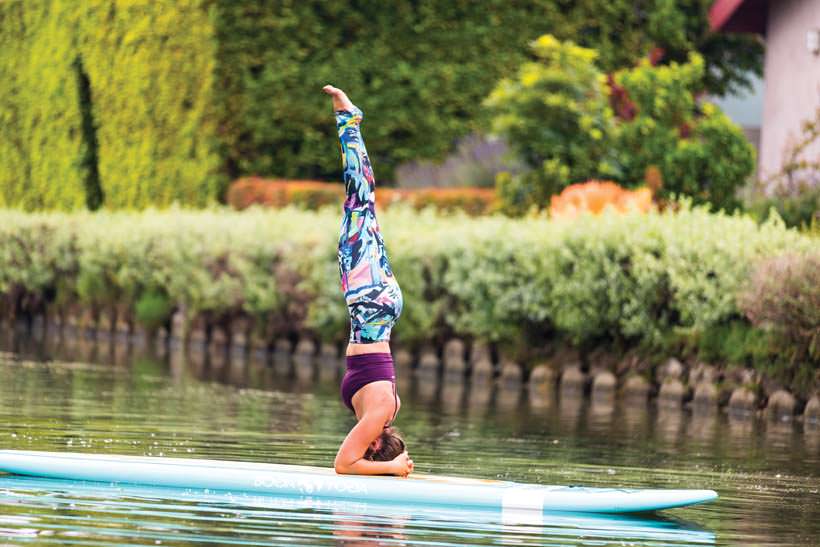
Sarah Tiefenthaler practicing SUP Yoga on a Boga Board. Sarah is wearing clothing by Reebok. Photo by David Young-Wolff.
Wow, you’ve been doing this for a while!
All of your Instagram posts are of you upside down on a paddeboard. Do you even remember who you used to be? What did you even look forward to on the weekend before you found SUP Yoga?! You’re thinking, “How do I do this more?” I know the feeling, so here’s my advice.
Get the Gear:
• Board
• Paddle
• PFD (personal floatation device)
• Anchor Set
• Straps for your car
• Leash (if you’re going to paddle on the open ocean or a river)
Ask yourself the following questions:
1. Do I have a place to store a board? Yes? Great! You can pick out a standard board. No? No problem—an inflatable board is your solution. Options include the BOGA Yoga Air, the Isle Surf and Sup’s Yoga Lotus Inflatable, or the Advanced Elements Lotus YSUP Inflatable. Inflatable boards folds up into a bag that you can easily throw into the back of any car or trunk.
2. Do I need a rack on my car to transport a solid board? You can strap a board onto most cars, racks or not.
3. What kind of paddle do I need? Choose an adjustable height paddle if you plan to share it with anyone. Otherwise get one cut to your height—about 4-6 inches taller than you.
4. For the anchor, you will need an eight-pound mushroom anchor, 30 feet of rope, and a carabiner. You’ll also need to fasten a little elastic loop to the back of your board to clip your anchor set onto.
5. Do you want to do more than just Yoga on your board? Then, maybe choose a touring board. A couple of options include the Mahina Blue (10’6”) or an Orange Classic (11’2”) by BOGA SUP. They’re still plenty sturdy but will paddle a bit more swiftly than a Yoga board.

Sarah Tiefenthaler practicing SUP Yoga on a BOGA board. Clothing by Reebok. Photo by David Young-Wolff.
Register for a SUP Yoga Teacher Training:
Even if you’re not sure you necessarily want to go on to teach SUP Yoga, you may be ready to learn everything there is to know. Look for classes that include World Paddle Association Level 1 Certification so you can develop skills in water safety, water rescue, paddle technique, and harbor and ocean safety. Other important skills include learning how to anchor a class, communicating balance cues, keeping students safe, and creating fun and effective yoga flows designed for the boards. Most SUP Yoga programs require that you already have a minimum 200-hour Yoga Certification in order to teach. There are a growing number of training programs available; at YOGAqua, we offer four four-day teacher training courses each year.
If you go on to teach floating yoga, no, it’s not quite as simple as walking through a studio door and rolling out a mat. You’re unloading boards, scrubbing them down, carrying heavy anchors, getting dirty, securing the safety of multiple students in the magnificence of Mother Nature. You’re a yoga teacher, a paddle instructor, a tour guide, a lifeguard, and a friend to your students.
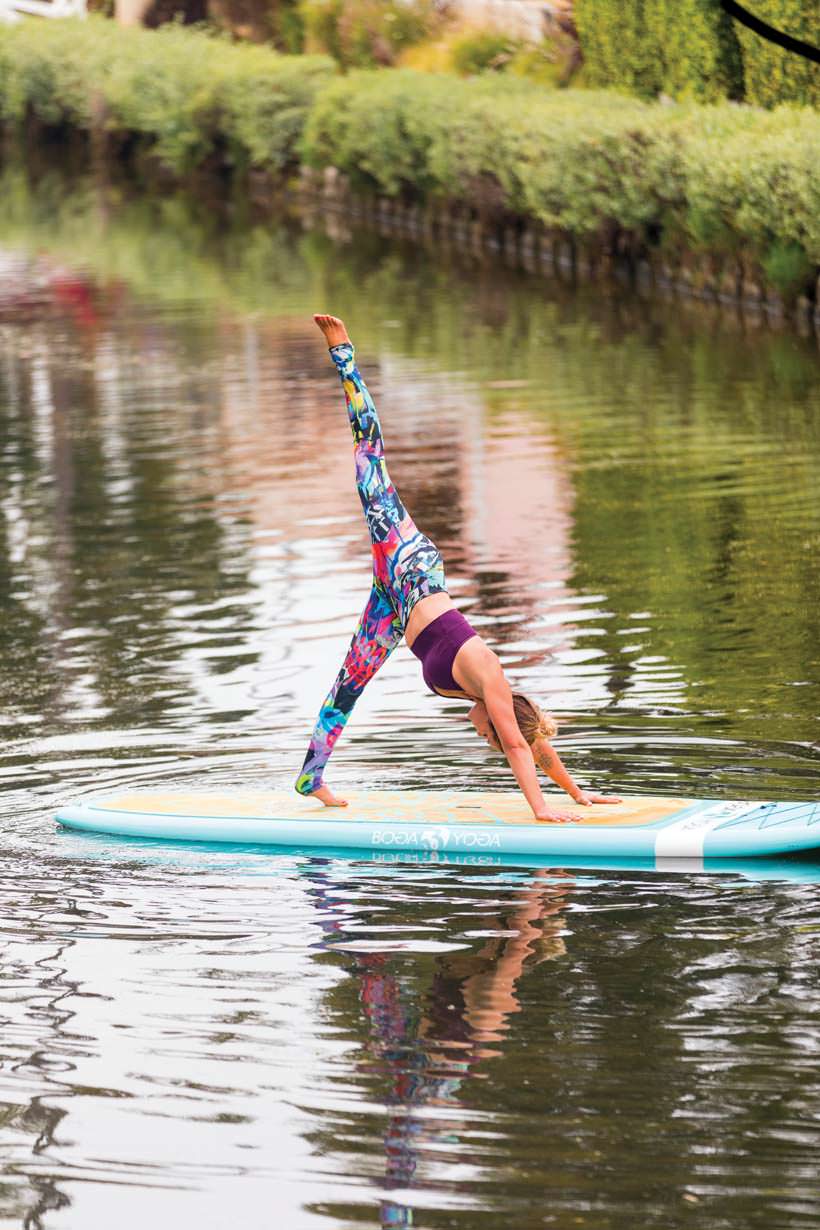
Sarah Tiefenthaler practicing SUP Yoga. Board by BOGA. Clothing by Reebok. Photo by David Young-Wolff.
Strike a Pose: Suggestions for Different Levels of Practice
New to SUP Yoga?
Pose: Kneeling Warrior 1
This is an excellent option to ease yourself into the Warrior series. Simply standing in a pose like Warrior 1 while floating on a board is pretty challenging!
What’s next?
Pose: Standing Warrior 1
I often tell my students that this pose can be more difficult than a headstand on a paddleboard. Why? Because of how you are distributing your weight along the board. When you are in a headstand, for example, all your weight is centered on the most stable part of your board making the pose more attainable. In the extended stance of Warrior I, you’re taking up more space on the board, so it asks more of your ability to maintain your balance.
You’ve been doing this for a while.
Pose: Crescent Pose
The slight difference of being on the ball of your back foot as compared to your foot being a 45-degree angle in Warrior 1 makes a huge difference on a SUP Board. Your legs will be working (meaning burning) in this one and it’s definitely a core workout to keep your balance in Crescent Pose.
All photos by David Young-Wolff.
Sarah is wearing Reebok Clothing in all photos: reebok.com
Sarah Tiefenthaler is the owner and founder of YOGAqua, a SUP Yoga company based in Marina Del Rey (founded in 2011). She specializes in providing safe and fun SUP Yoga experiences for students of all levels-from groups and private classes to retreats and teacher training programs. Sarah is the SUP Yoga Program Coordinator for Wanderlust Yoga Festivals and her home base is in LA. She is an ambassador for Reebok Clothing and BOGA Yoga Boards: yogaqua.com
